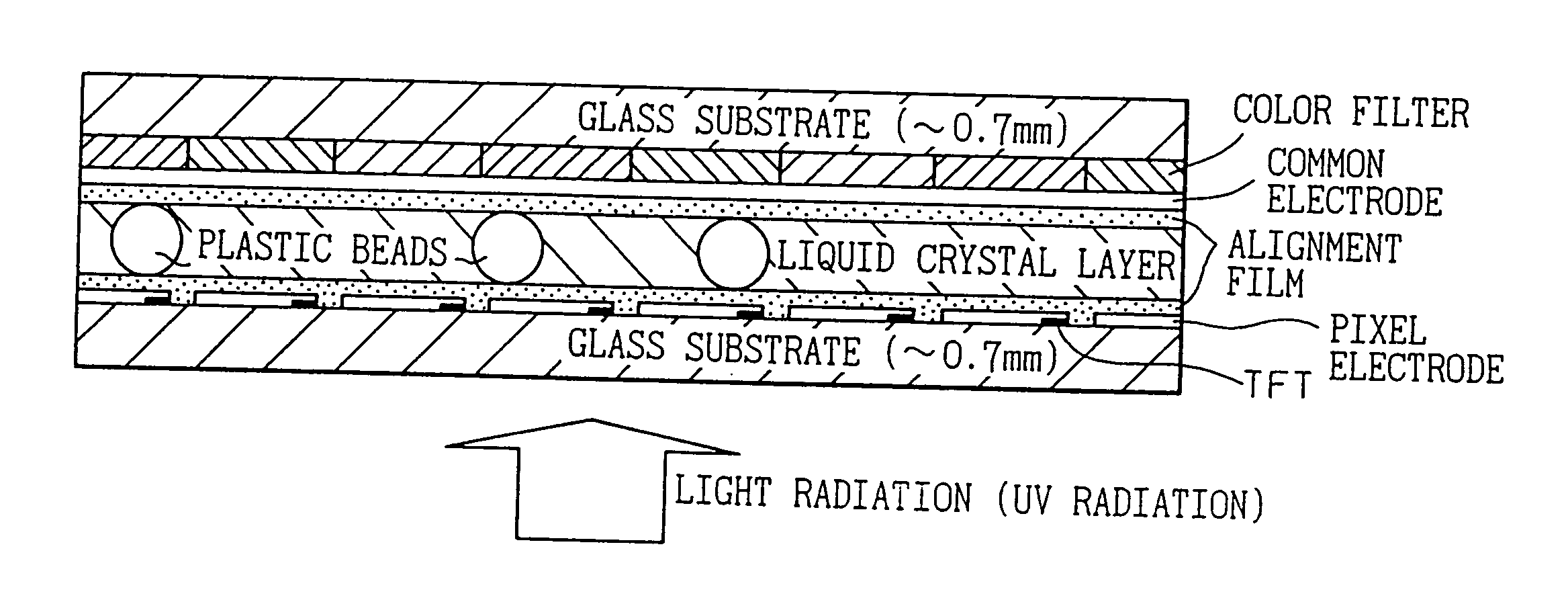Liquid crystal display device and method of fabricating the same
a liquid crystal display and display device technology, applied in non-linear optics, instruments, optics, etc., can solve the problems of inability to control the refractive index, the region where the tfts can be driven stably the region where the tfts can be driven from the desired region, etc., to achieve uniform alignment of liquid crystal molecules and stable operation
- Summary
- Abstract
- Description
- Claims
- Application Information
AI Technical Summary
Benefits of technology
Problems solved by technology
Method used
Image
Examples
embodiment 1
As shown in FIG. 9, gate bus lines and data bus lines are arranged in an matrix array on a first substrate, and the respective bus lines are bundled at one end. A TFT is located at each intersection of the bus lines, and a pixel electrode is formed via the TFT. On a second substrate on the opposite side is formed a common electrode which forms an electrical capacitance to each of the pixel electrodes, and a pad for applying a voltage to it is drawn out in the lower left corner.
The pixel electrodes also form a layer called a Cs bus line and an auxiliary capacitance Cs within the first substrate. It can be said that the Cs bus line is another common electrode. The Cs bus line is drawn out as a pad (Cs) in the upper right corner.
The cross section of the thus constructed liquid crystal panel is the same as that shown in FIG. 2; here, the first substrate corresponds to the bottom substrate and the second substrate to the substrate on which color filters are deposited.
On the surfac...
embodiment 2
Compared with the structure of the first embodiment shown in FIG. 1, the common electrode and the Cs bus line are completely insulated from each other in the structure shown in FIG. 12 (generally, they are short-circuited using conductive particles or silver paste). It is preferable to completely insulate the common electrode from the Cs bus line as illustrated here, because deterioration of the applied AC voltage can then be alleviated.
In particular, the resistance per Cs bus line is often of the order of several thousand ohms and, depending on the magnitude of leakage, the applied voltage drops.
embodiment 3
As described above, it is desirable that the common electrode and the Cs bus line be electrically insulated from each other, considering the voltage application when exposing the liquid crystal to radiation. This method, however, requires that a separate pattern from the voltage supply pattern to the Cs bus line be formed for the common electrode that needs to be supplied with currents from the four sides.
In view of this, if the common electrode is shorted to the Cs bus line after the radiation, as shown in the example shown here, supply of currents from the four sides can be easily accomplished.
More specifically, as shown in the example of FIG. 13, portions that can be shorted using a laser are provided in advance within the panel structure. For this purpose, it is generally practiced to electrically connect the top and bottom substrates by using silver paste or conductive spacer means.
On the other hand, in the example shown in FIG. 14, the connection is made at the terminal...
PUM
| Property | Measurement | Unit |
|---|---|---|
| polar angle | aaaaa | aaaaa |
| AC frequency | aaaaa | aaaaa |
| DC voltage | aaaaa | aaaaa |
Abstract
Description
Claims
Application Information
 Login to View More
Login to View More - R&D
- Intellectual Property
- Life Sciences
- Materials
- Tech Scout
- Unparalleled Data Quality
- Higher Quality Content
- 60% Fewer Hallucinations
Browse by: Latest US Patents, China's latest patents, Technical Efficacy Thesaurus, Application Domain, Technology Topic, Popular Technical Reports.
© 2025 PatSnap. All rights reserved.Legal|Privacy policy|Modern Slavery Act Transparency Statement|Sitemap|About US| Contact US: help@patsnap.com



